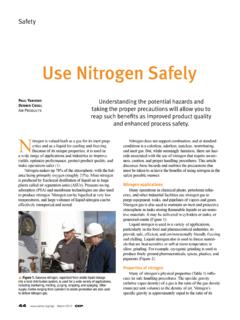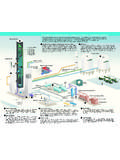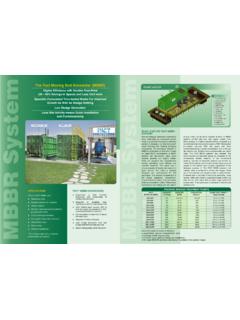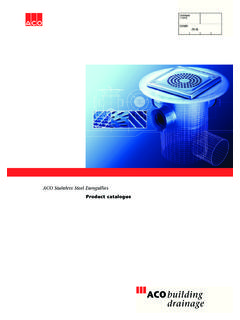Transcription of Use Nitrogen Safely - Air Products
1 44 March 2012 CEPS afetyNitrogen is valued both as a gas for its inert prop-erties and as a liquid for cooling and freezing. Because of its unique properties, it is used in a wide range of applications and industries to improve yields, optimize performance, protect product quality, and make operations safer (1). Nitrogen makes up 78% of the atmosphere, with the bal-ance being primarily oxygen (roughly 21%). Most Nitrogen is produced by fractional distillation of liquid air in large plants called air separation units (ASUs). Pressure-swing adsorption (PSA) and membrane technologies are also used to produce Nitrogen . Nitrogen can be liquefied at very low temperatures, and large volumes of liquid Nitrogen can be effectively transported and stored. Nitrogen does not support combustion, and at standard conditions is a colorless, odorless, tasteless, nonirritating, and inert gas.
2 But, while seemingly harmless, there are haz-ards associated with the use of Nitrogen that require aware-ness, caution, and proper handling procedures. This article discusses those hazards and outlines the precautions that must be taken to achieve the benefits of using Nitrogen in the safest possible manner. Nitrogen applications Many operations in chemical plants, petroleum refin-eries, and other industrial facilities use Nitrogen gas to purge equipment, tanks, and pipelines of vapors and gases. Nitrogen gas is also used to maintain an inert and protective atmosphere in tanks storing flammable liquids or air-sensi-tive materials. It may be delivered in cylinders or tanks, or generated onsite (Figure 1). Liquid Nitrogen is used in a variety of applications, particularly in the food and pharmaceutical industries, to provide safe, efficient, and environmentally friendly freezing and chilling.
3 Liquid Nitrogen also is used to freeze materi-als that are heat-sensitive or soft at room temperature to allow grinding. For example, cryogenic grinding is used to produce finely ground pharmaceuticals, spices, plastics, and pigments (Figure 2).Properties of Nitrogen Many of Nitrogen s physical properties (Table 1) influ-ence its safe handling procedures. The specific gravity (relative vapor density) of a gas is the ratio of the gas density (mass per unit volume) to the density of air. Nitrogen s specific gravity is approximately equal to the ratio of its Understanding the potential hazards and taking the proper precautions will allow you to reap such benefits as improved product quality and enhanced process YaniskoDennis CrollAir ProductsUse Nitrogen Safelyp Figure 1. Gaseous Nitrogen , vaporized from onsite liquid storage into a local distribution system, is used for a wide variety of applications, including blanketing, inerting, purging, stripping, and sparging.
4 Other supply modes ranging from cylinders to onsite generation are also used to deliver Nitrogen March 2012 45molecular weight to that of air (MWN2/MWair = 28/29 = ). A specific gravity less than 1 indicates that the gas is lighter than air and will rise, while a specific gravity greater than 1 indicates that the gas is heavier than air and will tend to settle. Nitrogen gas is only slightly lighter than air and readily mixes with air at room temperature. Cold vapors are more dense and will settle. Liquid Nitrogen , a cryogenic liquid, has a very low boil-ing point of 320 F. As indicated by its high liquid-to-gas expansion ratio, liquid Nitrogen produces large volumes of Nitrogen gas when it hazards of Nitrogen Nitrogen is sometimes mistakenly considered harmless because it is nontoxic and largely inert. However, it can act as a simple asphyxiant by displacing the oxygen in air to levels below that required to support life.
5 In addition, Nitrogen gas stored in pressurized containers and systems is stored energy that can cause serious injury or death if released in an uncon-trolled manner. Liquid Nitrogen also presents hazards due to its extremely low temperature and large expansion ratio. Oxygen deficiency Nitrogen can displace oxygen in the air, reducing the percentage of oxygen to below safe levels. Because the brain needs a continuous supply of oxygen to remain active, lack of oxygen prevents the brain from functioning properly, and it shuts down. Being odorless, colorless, tasteless, and nonirritating, Nitrogen has no properties that can warn people of its pres-ence. Inhalation of excessive amounts of Nitrogen can cause dizziness, nausea, vomiting, loss of consciousness, and death (Table 2). Death may result from errors in judgment, confu-sion, or loss of consciousness, which prevent self-rescue.
6 At extremely low oxygen concentrations, unconsciousness and death may occur in seconds and without warning. The Occupational Safety and Health Administra-tion (OSHA) considers any atmosphere with an oxygen level below to be oxygen-deficient and immediately dangerous to life or health. Personnel should not enter an area where the oxygen concentration is below unless they are using self-contained breathing apparatus (SCBA) or a supplied-air respirator. If the atmosphere s oxygen content falls to between p Figure 2. Liquid Nitrogen is used in certain particle-size-reduction pro-cesses to super-refrigerate material, including pigments, plastics, powder coatings, waxes, pharmaceuticals, nutraceuticals, spices, and other food Products . Liquid Nitrogen makes a material more brittle, allowing it to be easily broken up into small particles using less 1. Physical and chemical properties of Formula N2 Molecular Weight Point @ 1 atm F ( C)Freezing Point @ 1 atm F ( 210 C )Critical Temperature F ( C)Critical Pressure psia ( atm)Density, Liquid, @ Boiling Point, 1 atm lb/scfDensity, Gas @ 68 F (20 C), 1 atm lb/scfSpecific Gravity, Gas (air = 1) @ 68 F (20 C), 1 atm Gravity, Liquid (water = 1) @ 68 F (20 C), 1 atm Volume @ 68 F (20 C), 1 atm scf/lbLatent Heat of Vaporization 2,399 Btu/lb moleExpansion Ratio, Liquid to Gas, Boiling Point to 68 F (20 C) 1 to 694 Table 2.
7 Effects of oxygen Legal minimum concentration for humans (per OSHA regulation)15 Decreased ability to perform work; appear-ance of early symptoms in persons with coro-nary, pulmonary or circulation problems12 15% Increased pulse rate and respiration, impaired perception and judgment10 12% Further increase in pulse and respiration, giddiness, poor judgment, blue lips8 10% Mental failure, nausea, fainting, vomiting, unconsciousness6 8% 8 minutes, 100% fatalities; 6 minutes, 50% fatalities; 4 5 minutes, recovery expected<6% Coma in 40 seconds, convulsions, breathing stops, death46 March 2012 and 15%, a person s ability to work strenuously is reduced. Coordination may be impaired. As the oxygen content decreases further, perception and judgment are impaired. When the atmosphere s oxygen content falls to the 6% to 4% range, coma can occur within seconds.
8 The danger of Nitrogen asphyxiation is highest in con-fined spaces. However, fatalities and injuries can occur in open spaces, including areas with ventilation, laboratories, buildings, and outside in the vicinity of equipment. In these cases, the hazard of asphyxiation is not expected, and per-sonnel can be caught off-guard. Preventing oxygen deficiency To prevent oxygen deficiency, areas where Nitrogen is used require sufficient ventilation. At least four to six changes of fresh air per hour should be provided, depending on room size, the quantity of Nitrogen being used, the pres-ence of an oxygen monitoring system, and the overall area layout. Design features should also include pressure-relief devices to vent Nitrogen to a safe area outside. Because Nitrogen lacks properties that warn of its pres-ence ( , color, odor), an oxygen monitoring system should be installed in any indoor area where Nitrogen is stored or used.
9 Several types of oxygen monitoring systems, including personal monitors, portable handheld monitors, and station-ary area monitors, are available. Cold Nitrogen vapors can collect in low areas because the cold gas is denser than air. Evaluate areas where Nitrogen is used for the presence of confined spaces, such as tanks and equipment; test chambers; ditches, pits, and trenches (pipe trenches); furnaces; and rooms, especially basements. Display appropriate warnings outside confined-space areas. These spaces should be entered only by trained personnel using the established confined-space entry procedures devel-oped for that facility. Emergency response personnel should use SCBA or supplied air when entering a potentially oxygen-deficient atmosphere. Emergency response for a victim of oxygen deficiency should be carried out by trained personnel only. After the victim has been moved to an area with fresh air, the rescuer should administer oxygen if the victim is breath-ing, or start artificial respiration if the victim is not breath-ing.
10 Unprotected personnel should never attempt to rescue a victim by entering a confined space such attempts can result in additional victims as the rescuers are also overcome by oxygen deficiency. Vapor clouds Two types of vapor clouds can form from liquid nitro-gen. Liquid Nitrogen in exposed piping may cause mois-ture in the surrounding air to condense, creating a fog that reduces visibility but is otherwise harmless. However, a discharge of liquid Nitrogen itself creates a vapor cloud that is an asphyxiation hazard as well as a visibility hazard. Even outside, asphyxiation can occur in a Nitrogen -enriched vapor cloud. Remember, dense Nitrogen vapor tends to settle, so a person bending down in a Nitrogen vapor cloud increases his or her risk. Abnormal vapor clouds may be an indication of a leak and should be reported. Plant personnel should be trained to recognize vapor clouds associated with normal operations.






